

|
Sharing a beautiful gardening experience with you. |

|
COUCALS of MOUNT CROSBY |

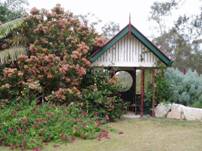
|
Because we are in our driest period, it is imperative to keep an eye on the watering, to make sure the beds do not dry out too much. The subtropical and tropical plants do expect a dry period and although they may look a little languid without water, they will recover well. It is best to wait until the summer rains come before planting any new plants as they need follow up water until their roots are established. Even drought tolerant plants need water when first planted.
I have found that during our dry spring the Pelargoniums are thriving. Many people think of these plants as Geraniums as they belong to the Geraniaceae family, but most of the plants we grow here are Pelargoniums, these include ivy, zonal, scented and standard. Pelargoniums come in a huge range of leaf types and colours and all are very tolerant of dry conditions. They don't like our humid summer so they need a dry, well drained position with plenty of air movement to get them through the summer. At the front of the garden is a good spot.
The following types do best for us; Zonals, have lovely leaf patterns and the leaves are often serrated on the edge and are usually low growing. Scented pelargoniums have lovely scented leaves of apple, peppermint, rose and lemon and the leaves are often finer and some are variegated. Ivy pelargoniums trail so are best on a bank where their stems can hang down. Their leaves are more shiny than the others and the flowers come in a wonderful range from white to burgundy. The standards are taller with thicker stems and also come in a wonderful colour range of flowers from white, through pink to pillar box red. I have even found a lovely yellow one.
They are great grown together in a mass planting with reds all together or red and white to give contrast. They grow well with Osteospernums which also come in a similar range of colours. Both plants flower at the same time and like a dry bed with some mulch. A good time to propagate them is either in the spring or autumn when the nights are cool. They are so hardy you can just pop a stem cutting straight into the garden. They do need a trim when they are looking 'lanky' and this can be done with hedge shears or secateurs.
The Cliveas are putting on a wonderful show. They look particularly good planted en-masse as most bulbs should be planted. They don’t mind our dry spring, in fact they relish in it and are quite happy under trees where they don't mind the competition of tree roots. Last years flowers are showing off lovely red and cream berries which can be left to seed naturally in-situ or potted and put in a bush house or under a shady tree. The cream berries are indicative of the plants with cream flowers and the red of the orange flowers. They do take several years to flower but are a good source of new plants and just maybe you will get a new type. I leave my Clivea plants to clump up rather than divide them as I find they flower better if left undisturbed. Cliveas are very undemanding plants and are happy with some leaf mould and mulch during the summer months.
Hippeastrums are another wonderful sub-tropical bulb which prefer to clump up and be left undisturbed. They don't like to be planted too deeply and like the necks of the bulb to rise above the soil level. I think it is lovely to have all of the one colour grouped together in a massed display. Unlike Cliveas, they prefer full sun and also appreciate mulching during summer. Their seeds are fine and papery and I have found them easy to propagate by sprinkling them on top of some potting mix in a poly styrene box and leaving the box under a shady tree or in a bush house. Like Cliveas they relish in our sub-tropical conditions. Hippeastrums do die back during our dry winter and re-emerge tall and proud, usually first with their flower spikes in early spring. They put on growth and multiply with moisture during the summer months.
Jobs to do: Cut back Brillantasia, Eranthemums, Senecio petasites, Poinsettias, Spiraea, Photinias, Banksian Rose and Eupatoriums after they have finished flowering. It is always wise to take cuttings of perennials in case you loose them or if you want more plants to put in. The cuttings can be put in a pot and put in a shady place and keep well watered. The Poinsettias will strike better if they are left a week to dry out a bit before you put the cutting into a pot of soil. Early morning is the best time to take cuttings. Cut a piece of stem about 50 mm below a good node and cut the top off, leaving a cutting about 30 cm long. Cut any leaves off the stem and place the node about 50mm below the level of the potting mix.
The Roses are starting to put on a great show, so don't fertilize them until rain is imminent. Pruning and deadheading will be beneficial as well as mulching. The bare rooted plants that arrived in July and that I put into pots are doing extremely well and some are flowering. I will leave theses in pots until the ground is nice and moist and then plant them out.
Collect seeds from Sweet peas and nasturtiums for next year’s crop. Store them in an envelope and mark with date and name. I also do this with vegetable seeds as I think it is better to re-seed tried and true vegetable strains than buy in ones you don’t know. When I collect seeds from Frangipani trees or vines which are large, I tie a paper bag around the stem so that they automatically disperse into the bag instead of the air and loosing them.
If we are lucky enough to get good rains fill in any gaps in the borders with cuttings taken earlier. Now is the time to plant Dahlia tubers and tree dahlia canes at the back of a border for an autumn display and coloured silverbeet, alternanthera and amaranth at front of the border to add colour to the garden.
Vegetables: Watering is essential in the vegetable garden in this hot and dry period. It is very rewarding to be able to pick a variety of herbs as well as silver beet, beans and tomatoes are not too far away.
Orchids: Repot Cymbidiums, Cattleyas, Dendrobiums Vandas and Oncidiums if they have: · outgrown their pots, i.e. they are growing over the side of the existing pot · the medium has broken down · they have finished flowering.
A good sign that orchid media has broken down is if there are weeds in the pot or if you see a white mould in the base of the pot.
I only divide orchids up once they have filled the largest pot or basket I can find, until then, I keep re-potting them into the next size pot (Terracotta of course) or hanging basket. Once the plant gets too big for its pot I start looking around to incorporate it into the garden. I did this a couple of years ago with some large Oncidium Sphacelatums. I put them in a sunny spot in the Bromeliad garden, raised up on logs in leaf mould and bark chips and they flower each November in their new location. There are Cattleyas and some orchids that I do not put into the garden, so if I do split them up I keep the divisions quite large as I find they recover and flower more quickly if left in a clump of 20 - 30 centimetres in diameter.
Make sure that the Phalaenopsis, Hardcane dendrobiums and any small orchids are misted daily on the days that are hot and sunny. This should be done early in the morning, so that they are dry by evening.
Keep a sharp eye out for the Dendrobium beetle. He loves the new leaves of the Dendobium speciosum as well as Cattleya and Vanda flowers. He is orange and will drop when he sees you, so hold your hand under him and then squash him. If you see a soft mushy mess in an eaten flower head it will be the larvae, which you will need to dispose of also.
Good Gardening Jan Flanigan
|
|
Irises |

|
Cliveas |
|
Hippeastrums |
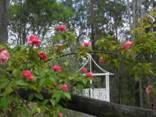
|
Rose Lorraine Lee |

|
Cattleya Orchid |
|
Echium |
|
Salvia |
|
Artemisia ‘Powis Castle’ |
|
What is featuring in the garden in OCTOBER: |
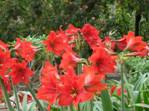

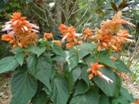
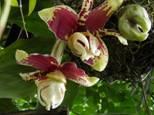
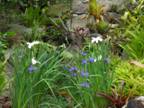
|
Home |
|
About Us |
|
Find/Contact Us |
|
What's happening |
|
Open Garden Days |
|
High Tea |
|
Orchid Growing |
|
Plants Grown |
|
Bus & Group Bookings |
|
Talks |
|
Project List |
|
In the garden |
|
Links |
|
Trees |
|
Shrubs |
|
Gardens Visited |
|
Stay with Us |

|
Shrubs/Trees |
Perennials |
Orchids |
|
Abutilon |
Acanthus Mollis |
Cattleya |
|
Alloxylon flammeum |
Aloes |
Cymbidium |
|
Ardisia |
Angelonia |
Epidendrum |
|
Azaleas |
Begonia |
Oncidiums |
|
Bauhinia |
Brillantasia |
Phaius |
|
Bougainvillea |
Cleome |
Phalaenopsis |
|
Brugmansia |
Coleus |
Softcane Dendrobiums |
|
Brunfelsia |
Coreopsis |
Zygopetalums |
|
Buddleia |
Cosmos |
Vandas |
|
Calliandra |
Daisies |
|
|
Callistemon |
Dianthus |
|
|
Dombeya calantha |
Evening Primrose |
Bulbs |
|
Echium |
Gaura |
Alstroemeria |
|
Eupatorium (mist bush) |
Gerbera |
Arthropodium (Renga Renga lily) |
|
Euphorbia cotinifolia (new leaves) |
Heliotrope |
Cliveas |
|
Fiddlewood (turning yellow) |
Impatiens |
Day Lilies |
|
Gardenia |
Justicia |
Gladioli (species) |
|
Grevillea robusta |
Kalanchoe |
Hippeastrums |
|
Grevilleas |
Lavender |
Irises Lousiana |
|
Hibiscus |
Leonitis |
Lilliums |
|
Jacarandas |
Mandevilla |
Ornithogalum |
|
Lorapetalum |
Nasturtiums |
Tulbaghia |
|
Photinia |
Nicotiana |
Watsonias |
|
Polygala |
Orontium (water) |
Bromeliads |
|
Pomegranate |
|
|
|
Robinia Pseudo-acacia ‘freesia’ (new leaves) |
Pansies |
Aechmea |
|
Rondaletia |
Papaver |
Billbergia |
|
Roses |
Pelagoniums |
Guzmania |
|
Schotia brachypetala |
Pentas |
Hohenbergia |
|
Spiraea cantoniensis |
Plectranthus |
Tillandsia |
|
Viburnum |
Russellia |
Vriesia |
|
Graptophyllum ilicifolium |
Salvias |
|
|
|
Scutilleria |
Vines |
|
|
|
Clytostoma callistegioides |
|
|
Statice (perennial) |
Cobaea Scandens |
|
|
Torrenia |
Banksian Rose |
|
|
|
Dalechampia |
|
|
Turnea |
Jasminum |
|
|
Waterlillies |
Mandevilla |
|
|
|
Maurandya (climbing foxglove) |
|
|
|
Pandorea pandorama |
|
|
|
Phaseolus caracalla |
|
|
|
Tecomanthe hillii |
|
|
|
Wisteria |